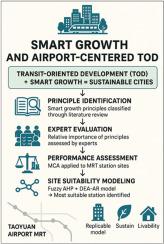智能增长原则和以机场为中心的TOD:可持续选址的框架
IF 6.3
2区 工程技术
Q1 ECONOMICS
引用次数: 0
摘要
交通导向发展(TOD)模式作为一种创新的交通规划策略已经出现,以提高城市生活质量。有证据表明,将智能增长原则融入TOD可以进一步促进更健康、更宜居和可持续的城市环境。本研究建立了一个以方法为导向的框架,将智能增长原则纳入城市交通规划策略,并采用客观科学的方法进行实证分析。以台湾桃园机场捷运系统为例。采用多标准分析(MCA)对TOD规划绩效进行评估。首先,通过文献综述来识别和分类智能增长原则。然后,六位专家评估了这些原则的相对重要性。最后,以桃园机场捷运沿线的站点为例,验证此方法的有效性与优势。为了确定最合适的站址,我们采用了模糊层次分析法和数据包络分析法相结合的模型,并结合保证区域法。建议的方法和框架可以应用于其他旨在提高城市可持续性和宜居性的城市或发展项目。本文章由计算机程序翻译,如有差异,请以英文原文为准。

Smart growth principles and airport-centered TOD: A framework for sustainable site selection
The transit-oriented development (TOD) model has emerged as an innovative transport-planning strategy for enhancing urban quality of life. Evidence suggests that integrating smart growth principles into TOD can further promote a healthier, more livable, and sustainable urban environment.
This study develops a method-oriented framework that incorporates smart growth principles into urban transportation planning strategies and employs objective scientific methods for empirical analysis. The Taoyuan Airport Mass Rapid Transit (MRT) system in Taiwan serves as the case study. A multicriteria analysis (MCA) was conducted to assess TOD planning performance. First, a literature review was used to identify and classify smart growth principles. Then, six experts evaluated the relative importance of these principles. Finally, station sites along the Taoyuan Airport MRT were selected to demonstrate the validity and advantages of the proposed methodological approach.
To identify the most suitable station site, we applied a model combining the fuzzy analytic hierarchy process and data envelopment analysis with the assurance region approach. The proposed method and framework can be applied to other cities or development projects aiming to enhance urban sustainability and livability.
求助全文
通过发布文献求助,成功后即可免费获取论文全文。
去求助
来源期刊

Transport Policy
Multiple-
CiteScore
12.10
自引率
10.30%
发文量
282
期刊介绍:
Transport Policy is an international journal aimed at bridging the gap between theory and practice in transport. Its subject areas reflect the concerns of policymakers in government, industry, voluntary organisations and the public at large, providing independent, original and rigorous analysis to understand how policy decisions have been taken, monitor their effects, and suggest how they may be improved. The journal treats the transport sector comprehensively, and in the context of other sectors including energy, housing, industry and planning. All modes are covered: land, sea and air; road and rail; public and private; motorised and non-motorised; passenger and freight.
 求助内容:
求助内容: 应助结果提醒方式:
应助结果提醒方式:


